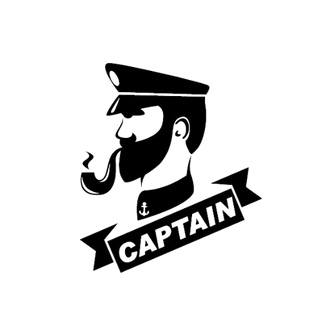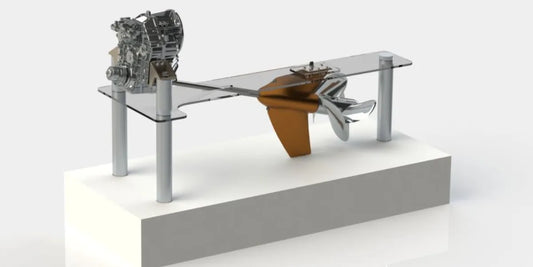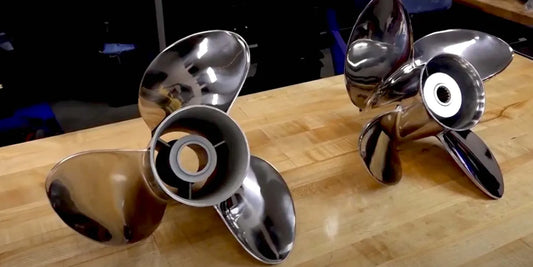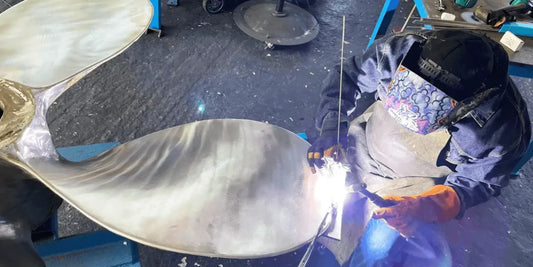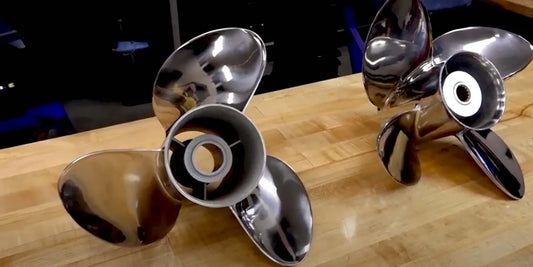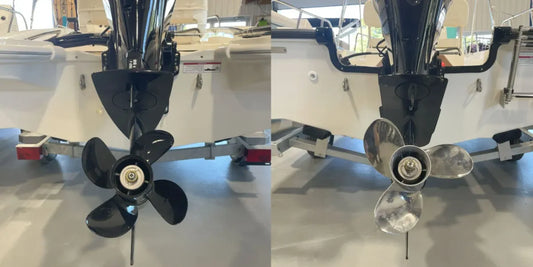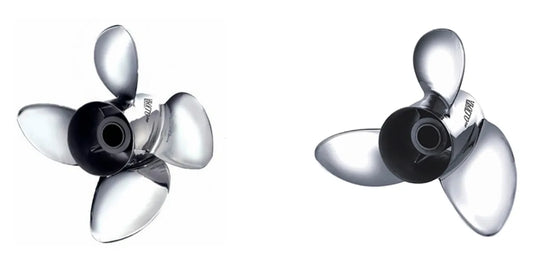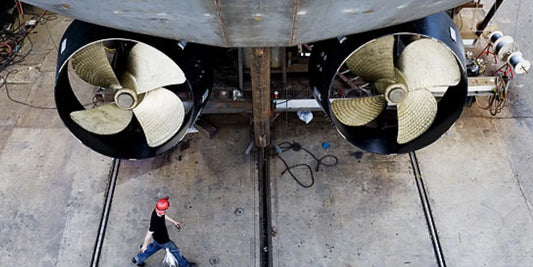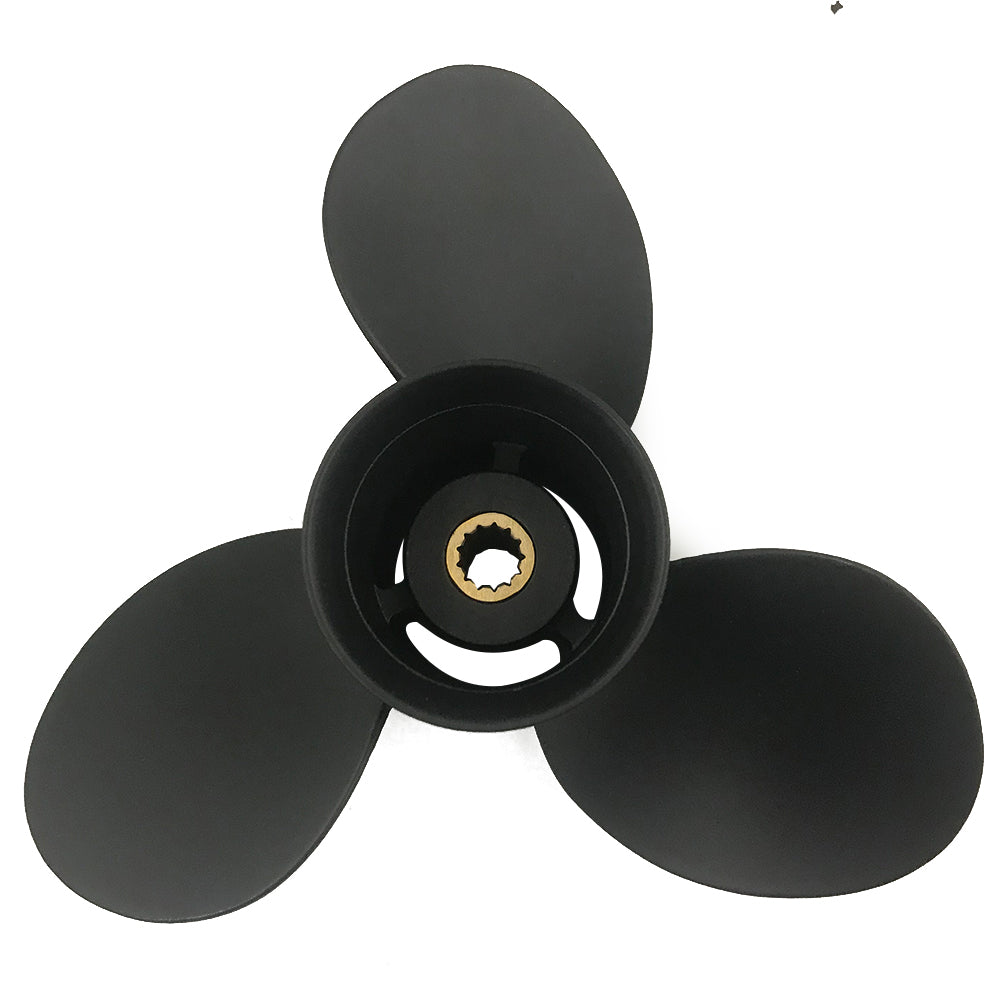To ensure smooth sailing, good performance, and the extended life of the equipment, propeller maintenance on a sailboat is significant. Now, more than ever, prioritize maintenance, whether it's your folding or feathering prop, given the new technologies and environmental factors in 2025. This will discuss the top five major tips for keeping your propeller in great shape while doing its best job. From dealing with marine growth to lubrication, these tips will help you maintain your investment and thus allow stress-free ventures into the waters. Continue reading to see how little state-by-state actions can bring in sizeable gains to your sailing experience.
Understanding Sailboat Propellers

Kinds of Sailboat Propellers
Sailboat propellers are broadly divided into three types for performance considerations and the designs of vessels:
Fixed-Blade Propellers: These are the most common and economical types to install on any vessel. With fixed-blade propellers, blades stay fixed and do not fold or feather. The surface area of such fixed blades generally means a stronger propulsive force. Still, the blades also create a lot of drag when the boat is propelled solely by the wind, significantly reducing sailing efficiency.
Folding Propellers: Designed to reduce drag by allowing the blades to fold when not in use, folding propellers are highly sought after by sailors who emphasize under-sail speed and performance. Folding propellers come in two-blade, three-blade, and even four-blade setups to provide options for different performance requirements with sailing and motoring.
Feathering Propellers: The feathering propeller strikes a balance between performance and drag reduction. Unlike the folding sort, feathering blades turn to align with the flow of water when idle, and thus significantly reduce drag. For competitor sailing and cruising, these propellers offer performance and thrust efficiency rendering.
Every kind of propeller comes with its vectors of advantages and drawbacks; therefore, it is relevant to take into account such factors as your sailing style, type of vessel, and maintenance priorities when choosing the right option. Advancements in modern materials and engineering further boost the endurance and efficiency of various types, and keep the good name of sailors for a more extended period.
Choosing Between Folding and Feathering Propulsion
Choosing between folding and feathering propellers should be based on evaluating their effects on performance, efficiency, and maintenance. Folding propellers are designed to fold the blades backward, thereby avoiding drag during sailing without engine use. From the perspective of racing yachts or performance-oriented sailors, this is precisely what one wants. The designs are very lightweight and streamlined, so under certain conditions, they can improve sailing speed and fuel efficiency.
Conversely, feathering propellers are a class of propellers whose blades rotate to a neutral angle to reduce the resistance water faces while under power, allowing better maneuverability. A true advantage is given to cruising sailors who prioritize the ability for good reverse and tight, precise steering in docking situations. Improvements in material sciences and engineering have made both types of propellers more durable and reliable, offering long-lasting benefits for sailors, regardless of which type they choose.
Depending on your vessel type, usual sailing conditions, and requirements for either higher speeds and less drag or better handling and reverse thrust, you will have to make decisions accordingly. Additionally, their prices should be considered; the folding ones may need less maintenance over time, whereas such maintenance intervals may become more frequent with a feathering. This will largely be due to their intricate mechanism.
Pros of 2-Blade Propellers Against 3-Blade
When one considers the advantages of 2-blade versus 3-blade propellers, performance, efficiency, and suitability for various sailing applications become essential. 2-blade propellers, given their smaller drag, are preferred in light winds and are an excellent choice for sailing vessels that prioritize less drag and fuel savings. These 2-blade propellers are easy to rotate, ensuring smooth sailing, especially on lighter wood boats.
On the other hand, 3-blade props increase thrust and extend stability, making them great for motorized crafts or sailboats that mainly run on power. The additional blade allows better handling in adverse weather, reverse thrust is stronger, and the 3-blade prop system allows more vigorous thrust forward in heavy seas or while carrying larger loads. They, in fact, produce more drag than two blades do, but the additional benefits of thrust and performance that come with greater power levels come with consideration.
In the end, deciding between a 2-blade or 3-blade propeller must be evaluated based on the specific requirements of your vessel's use and the efficiency considered against power criteria.
Maintenance Tips for Sailboat Propellers

Regular Inspection and Cleaning
Proper sailboat propeller maintenance indeed begins with periodic inspections and cleaning. Look for damage such as cracks, bends, or heavy wear that may affect performance. Barnacles, algae, and marine growth have time to accumulate on the propeller, causing inefficiency and excess fuel consumption. Cleaning the propeller regularly, either manually or with specialized cleaning tools, ensures it maintains good performance and reduces drag.
Inspections must precede and follow the sailing season, especially for the prolonged use of a propeller. Rigorously check that the propeller is really sitting securely on the shaft, and all nuts and bolts or cotter pins are in place. Maintaining work in this manner will not only help keep it efficient but also extend its life.
Checking for Damage on Blade Props
Regularly checking blade props for damage is crucial for safety and proper operating efficiency. Begin by scanning for visible indications of wear: cracks, dents, or corrosion on the blades. Any slight imperfection could affect performance as imbalances or drag might be introduced. Attempt the manual rotation of the propeller; it should move smoothly. Bending of blades will cause vibrations and less efficiency.
A submerged prop should be routinely checked for marine growth or debris that may have attached itself to the blades. In the case of small chips or uneven surfaces, these can be corrected using dedicated repair kits. However, if the damage is more severe, it will have to be serviced professionally or perhaps replaced entirely. Through consistent inspection and immediate repair of potential problems, you will prolong the service life of blade propellers and generally reduce the chance of an unexpected failure.
Importance of Pitch Adjustments
Propeller pitch adjustments are one of the critical considerations in maximizing the working efficiency of a blade propeller on a watercraft. Varying the pitch of the blades can increase speed, reduce fuel consumption, or improve handling of the vessel. Low pitch is best suited, say, for towing or when demanding strong thrust at low speeds, whereas high pitch implies faster speeds but high power requirements of the engine. Either of the inappropriate pitch settings would adversely impact engine operation, under-revving the motor or straining against unnecessary loading capacity, ultimately leading to long-term mechanical problems. It is generally accepted among experts and supported by empirical data from marine performance testing that boats with proper propeller pitch settings achieve a 10-15% improvement in fuel efficiency, along with smoother operation. Commitment to understanding and setting the appropriate pitch for the activity and boat can yield excellent performance results and ensure that the entire system for the propeller and engine remains intact longer.
Best Practices for Propeller Storage

Folding Propeller Storage Tips
To keep the folding propeller in working condition and to prolong its life, it should be stored properly. First, clean the propeller to remove salt and other inorganic solids and organic materials that might cause corrosion or damage over time. The propeller should then be thoroughly air-dried to avoid moisture retention problems. Apply marine-grade lubricant on all moving parts in the lightest possible coat so it will keep rust at bay, smoothening their operation on reinstallation. Likewise, check for any visible damage, such as nicks or cracks, and rectify them before storage, so they do not cause any problems in its subsequent functioning.
A folding propeller should be stored in a cool and dry place, out of direct sunlight, as it may weaken certain materials over time. Use a protective case if available or cover the propeller with a soft cloth or bubble wrap to prevent scratches while handling or transporting it. Following these simple steps will prepare your folding propeller for future use while safeguarding its integrity and performance.
Winterizing Your Sailboat Propeller
When a sailboat propeller is adequately winterized, it remains in an optimal state during the off-season. Using fresh water, wash the propeller to remove salt, dirt, or other marine growth that could otherwise cause corrosion and potential damage over time. Then go through wear, cracks, or points that might require cleaning and fixing. Once cleaned and inspected, apply a thin layer of marine-grade grease or antifoul spray on the propeller surfaces to inhibit corrosion and fouling during storage. If your propeller is detachable, remove it and place it in a temperature-controlled, moisture-proof location for additional protection. Check the seals and bolts for wear and ensure they are secure right after preparing for the new sailing season. This gives you the best chance to maintain the propeller, reduce maintenance costs, and achieve maximum performance just in time to get on the water again.
Choosing the Right Storage Medium
Selecting the right storage environment for your boat and its components improves their preservation during the off-season. Ideally, it should be dry, well-ventilated, and protected against any seasonal temperature fluctuations, as humidity and heat can cause rusting and material deterioration. Indoor storage facilities oftentimes form the very best storage option, shielding the boats from rough weather conditions and harmful UV rays. If an inside storage area is unavailable, keep the ship under the best covers and tarps, which will repel moisture and prevent damage from constant sun exposure. Studies prove that boats stored in a controlled environment require far less maintenance and are less likely to suffer diminution in the long run; therefore, proper storage is an investment every boat owner should make.
Upgrading Your Sailboat Propeller

When to Consider a 4-Blade-Folding Propeller
For sailboat owners who want performance and variable sailing conditions, the propeller must be chosen accordingly. In such cases, a 4-blade folding propeller ensures smooth operation, good thrust, and easy handling in rough waters or against strong currents. With this 4-blade configuration, there is much less noticeable vibration when compared with a traditional fixed or 2-blade configuration, allowing for an enjoyable and steady experience in tight quarters or docking.
The modern 4-blade folding propellers are also designed to provide a drag reduction under sail, thereby increasing speed and fuel efficiency. These are really the choice for those desirous of finding a happy medium between engine efficiency and sailing performance without having to substitute the sensation of gliding silently through waves under wind power. Principal research on propeller efficiency results in the conclusion that such an upgrade will ensure a better general sailboat performance, whether local or long-distance.
Advantages of Nibral and Bronze in Propellers
Being highly durable, efficient, and resistant to corrosion, Nibral and bronze propellers are known for their application for sailboats and marine vessels. The Nibral props, more particularly, offer deformation resistance under high stress, thus achieving a longer lifespan and consistent performance. Both materials provide superb anti-corrosion properties, a necessity in any maritime situation where saltwater exposure is prolonged.
Furthermore, these materials ensure a balance of strength and weight, optimally aiding thrust while reducing drag. Studies have demonstrated that Nibral propellers resist wear better than bronze ones, owing to their higher nickel content, and thus find application in more demanding usages. On the other side, bronze propellers have often been considered the workhorse, staying firmly in the recreational boating scene due to their relatively cheaper cost and ease of upkeep. Vessel owners can thus readily bank on the synergy of the materials and contemporary engineering for optimum efficiency at least in operating costs.
Comparison between Michigan Wheel and Flexofold Choices.
When Michigan Wheel and Flexofold propellers were evaluated, notable distinctions arose regarding design, performance, and specific use. Michigan Wheel propellers are renowned for their fine engineering and are available for both commercial and recreational boats. These propellers emphasize durability and precision in their engineering and have incorporated advanced materials like nickel bronze for the highest quality. They even allow customizations to accommodate the requirements of various types of vessels needing Michigan Wheel propulsion. Michigan Wheel has been able to provide a very reliable propulsion system for boats, placing a premium on long life and performance consistency.
What I mean is, Flexofold propellers are perfect since they fold. You'll want to have them on any sailing yacht. Their folding blade design actually increases sailing performance by reducing drag when the engine is turned off. Flexofold propellers are made of quality materials, with stainless steel performing well to ensure strength and corrosion resistance. By cutting drag and the need for fuel, these propellers give a slight edge in competitive racing or long-distance cruising.
Performance data have shown that propellers with Michigan Wheels tend to provide greater thrust to speedboats and heavy vessels, ensuring maximum efficiency in challenging marine environments. On the other hand, Flexofold propellers maintain a pull-down sailing speed; yachts equipped with these features enjoy maximized benefits for sailing performance. Deciding between the two really comes down to that type of vessel and the usage one is after, and how they want their cost-efficiency trade-off to go. Knowing these dissimilarities will help a vessel owner decide on the best option for their specific needs.
Common Issues with Sailboat Propellers

Diagnosing Propeller Cavitation
Based on my observations, propeller cavitation happens when a sailboat's propeller moves so fast that the pressure on the water around the blades quickly drops. This pressure drop causes vapor bubbles to form, which collapse violently, producing noise, vibration, and, over time, damage to the propellers. One of the most common signs of cavitation is reduced propulsive force, accompanied by strange noises or vibrations around the propeller. If the problem is not solved, cavitation may begin to wear down the edges of the blades, thus diminishing performance and requiring expensive repairs.
Cavitation problems can be solved only when the causes behind them are known. Commonly, cavitation arises from too small propellers, propellers working at excessive speeds, and minute blade surface defects. Minor blade wear, nicks, and deformations would very much disrupt the smooth flow of water past the surfaces. Moreover, ensure the propeller is the correct size and pitch for the given sailboat and engine setup to minimize cavitation. A marine technician or propeller specialist will be able to assist you with finding the proper setup.
When fixing cavitation, typically one designs a propeller that decreases the probability of pressure imbalances. A few of the newer propellers employ blade shapes or surface coatings that prevent cavitation in the first place. Prevent the growth of marine organisms and damage to the propeller from occurring each time, because a clean and well-maintained propeller will perform better. Such maintenance I believe improves the speed of sailing while also contributing to the resolution of cavitation for overall benefit and longevity of the propeller system.
Corrosion in Bronze Propellers
Corrosion treatment of bronze propellers comprises prevention and corrective maintenance. From my experiences, one of the best safeguards against corrosion is providing adequate cathodic protection. Proper installation and maintenance of sacrificial anodes, which are zinc or aluminum anodes, serve to protect the bronze propeller by becoming the preferred site for corrosion instead of the propeller itself. It is imperative to ensure these anodes are checked regularly and replaced, if necessary, to uphold their effectiveness. Also, I personally avoid mixing metallic materials in contact with the propeller shaft since this may increase galvanic corrosion.
Another essential ingredient in this recipe for affording some protection against corrosion has been the application of a high-quality anti-corrosion coating to the bronze propeller. Most coatings today are meant to physically prevent the ingress of salt water and other corrosive elements onto the metal. Depending on which coating is used, it may also deter some fouling, which usually results in uneven corrosion over time. Make sure the propellers are regularly cleaned of barnacles, algae, or any other growth, as these provide conducive environments for accelerating corrosive processes.
Monitoring the water quality and pH levels in the waters I sail through has proved helpful, as more acidic or contaminated waters can become corrosive over time. Scheduling regular check-ups by a professional keeps you ahead in the game of propeller maintenance. The amalgamation of the measures described above has dramatically helped me extend the lifespan of bronze propellers, ensuring they act reliably and efficiently under different sailing conditions.
Understanding Vibrations and Noise from Your Prop
Considering the vibrations and noise from my prop has been essential for smooth and efficient sailing. Vibrations can come from factors such as propeller damage, improper alignment, or marine growth on the blades. Even minor nicks and dents on a prop can cause imbalance, disturbing the even flow of water and increasing vibrations. Whenever I notice even slight changes in the regular smooth operation of my shaft and rigging assembly, I check my propeller for signs of wear, tear, or damage, and clean off any fouling organisms. Such inspections and cleaning are essential for maintenance since they help prevent the problem from becoming worse.
Vibration and noise may also result from a misaligned shaft or a worn cutlass bearing. When the propeller shaft and engine do not align well because of wear or poor installation, vibrational issues usually arise, sometimes accompanied by quite noticeable noise. I remain proactive by having a professional check for alignment from time to time and replacing the cutlass bearing when necessary. Furthermore, I have learned that an improper match of propeller size or pitch can also result in unnecessary vibrations. One should consult manufacturers or marine mechanics to ensure that the propeller is the right one given the engine and vessel specs.
Cavitation noise is one of the best-known noises and occurs when bubbles form due to the lowering of water pressure near the propeller blades, transitioning from collapsing to loud buzzing or hissing. So much noise is generated that, over time, it can also lead to imperfections in the propeller. To cure the problem of cavitation, I try to maintain appropriate speeds and loads and ensure the propeller is in good condition. On these grounds, I have been able to cut down the vibrations and noise substantially for an enjoyable and peaceful cruising experience.
Reference Sources
-
Propeller care: everything you need to know - A comprehensive guide on propeller maintenance, including its importance and practical tips.
-
7 Tips for Boat Propeller Maintenance - Detailed steps for cleaning, inspecting, and maintaining your boat propeller.
-
How To Change A Boat Propeller The Right Way - A resource focusing on proper techniques for changing and maintaining boat propellers.
Frequently Asked Questions (FAQs)
What is the relevance of a sailboat propeller for propulsion?
A sailboat propeller is crucial for effective propulsion, especially when the sails aren't enough. The design, ranging from 3-blade to 2-blade propellers, ultimately affects performance. If the right prop is chosen, there will be less drag, meaning the vessel will perform better in terms of speed and maneuvering. Sailboat owners generally select propellers based on the engine size and thrust they need. The type and relationship between the pitch and diameter of the propeller should be well understood to meet the requirements satisfactorily, ensuring the vessel operates efficiently in all aspects.
How can I tell what type of propeller I should be going for on my yacht?
Choosing the right type of propeller for a yacht depends on considerations like shaft information, engine power, and sailing conditions. A three-blade configuration usually produces more thrust and is hence more efficient than an oval-shaped two-blader. Further, you must scan the sale of propellers from reputable manufacturers compatible with your sail drive or inboard system. The pitch must match the speed and performance parameters for which the boat is intended. The least drag for a vessel must always be set as its prime mover for any operations, depending upon enough torque available for that particular vessel.
What benefits does a feathering propeller offer to a sailboat?
A feathering propeller greatly improves the performance of the sailboat by minimizing drag while going under sail. While fixed pitch designs hold the blades at a set angle, a feathering design allows the blades to orient with the flow of water, minimizing resistance. This is an advantage for sailors who want to maximize speed without losing engine efficiency. Along with being able to move a boat in tight spaces, feathering props is a very favorite option with experienced owners. They can also be more efficient at high RPMs, making them suitable for a wide range of cruising conditions.
What's the difference between the fixed-pitch and the adjustable-pitch type of propeller?
A fixed-pitch propeller has blades set at a specific angle, which is excellent for certain sailing conditions but quite limiting in terms of versatility. The ability to vary pitch allows for adjustments in thrust and improvements in efficiency according to current sailing needs. Operators may choose adjustable pitch when cruising to get better performance through the range of speeds. The fixed-pitch ones, however, are quite simple and lightweight, making them ideal for smaller-scale boats or those that desire very little upkeep. Generally, it depends on the sailor's personal preference and the conditions encountered while sailing on a particular day.
How do diameter and pitch affect sailing performance?
How about a propeller diameter and pitch to talk about the basis of sailboat performance? Larger diameter propellers create greater thrust at the expense of drag. Small-diameter propellers have less drag but might not exert sufficient thrust on bigger vessels. Pitch is how far the ship moves ahead by one rotation. The propeller's pitch must be appropriately designed to match the engine power to attain optimum efficiency. Size and pitch-balanced propellers would provide the best cruise performance while creating minimum resistance under sail.
What are the common materials for making propellers for sailboats?
The propellers of a sailboat are generally made of bronze, nibral, or plastic. Bronze is preferred because it is a durable, corrosion-resistant metal and an enduring marine option. Nibral, consisting of nickel, bronze, and aluminum, is strong and efficient and is perhaps best deployed on faster sailboats. Plastic propellers, though light and cheap, probably do not have the same durability as their metal counterparts. Each material has pros and cons; your choice thus depends on your style of sailing and the requirements of your vessel.
